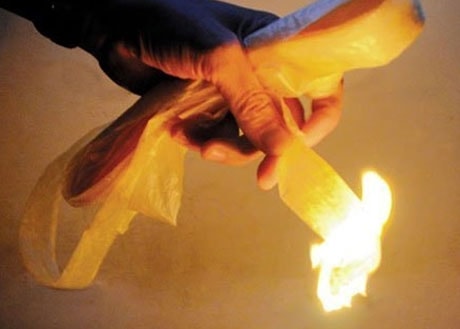Sausage wrappers made of plastic?
Instead of using pig intestines to make sausages, many manufacturers of this item have switched to using a new type of casing that has properties similar to nylon.
According to many consumers, recently, when buying sausages, people discovered that the outer shell (which is made of pig intestines) was unusually tough. Many people, after chewing for a long time but "couldn't swallow", suspected that it was a plastic shell and not pig intestines as traditionally made. Even the management agency has not been able to explain this abnormality.
Mr. Tran Quoc Nhuan, Director of Hung Tuan Lap Xuong Company Limited (headquartered in District 11, Ho Chi Minh City) said that in the stages of making sausage, the most time-consuming stage is still the stage of processing pig intestines to make the sausage skin.
To make delicious sausages, you need to use fresh pig intestines, scraped clean, until the outer layer is as thin as a layer of nylon. However, only on a family scale can this be done manually. According to Mr. Nhuan, most establishments or businesses that make large quantities have switched to using a special type of dried pig intestines, which have been pre-processed.
Facilities that buy dried pig intestines only need to stuff the raw materials in before drying them. These intestines are folded into stacks, each stack weighs about 100g, and can be up to 11-12m long. If it weren’t said that they were pig intestines, everyone would think they were plastic.
Mr. Nhuan also wondered about this type of casing and was informed by the suppliers that the pig intestines are processed using the same technology as the "tanning" method, so even though a pig only has a few meters of intestines, with this method, the pig intestines can be connected to hundreds of meters long.
According to some owners of handmade sausage production facilities in Binh Chanh District (HCMC), this special type of pig intestine is sold retail at some markets in District 5 and District 6 and is imported from China. With the need to buy dried pig intestines to make sausage, through many stalls at Binh Tay Market (District 6, HCMC), An Dong (District 5, HCMC), we were guided by the traders to Thanh Ky stall at An Dong Market, which is known as a main agent supplying goods to some sausage production facilities and retail buyers.
We had just asked to buy, the stall owner pulled out many bundles of “dried pig intestines” in large bags, along with an invitation to buy as many as we wanted. It was surprising that a bundle of dried pig intestines could produce a sausage block 11-12m long but the retail price was only 30,000 VND.

The sausage casing burned like plastic.
Meanwhile, with that amount of money, if you buy fresh, homemade pig intestines, you can only get no more than 2m. According to the stall owner, because it is both cheap and convenient, this item is being asked to buy by many customers. Through some simple experiments we conducted such as burning it on fire, soaking it in water... with a pile of "pig intestines" bought at the market, this material seems to be more similar to nylon or rubber than a food. For example, when heated on fire, this material shrinks and shrinks very quickly, has a burnt smell of plastic (photo on the side), and when soaked in water for five to six hours, it is waterproof, showing no signs of being crumbly.
Having witnessed a sausage production facility in Binh Chanh using this special type of "pig intestine", Mr. Bang Duc Lieu, Deputy Director of the Veterinary Center of Region VI, was also surprised. Mr. Lieu said: "We will soon consider this issue because surprisingly, pig intestines are not on the list of animal products that need to be quarantined by the veterinary agency, while the origin of the products is unclear."
According to Dr. Tran Van Ky, head of the Southern office of the Vietnam Association for Food Safety Science and Technology, nylon or plastic in general is a type of chemical that is only used as outer packaging for food and is not part of the group of additives, colorants, etc. used directly with food.
Even when used as packaging, plastics that do not meet safety requirements can produce toxins that contaminate food and harm the health of consumers. If dried pig intestines are faked with plastic, and people eat them directly, the hidden danger is much greater.
However, there is currently no research and conclusion on exactly what material this sausage casing is made of, so it is difficult to make recommendations on the level of harm that can affect users. Consumers should not choose to buy products that they doubt about the safety, especially products that are not on this control list.
Vissan Company representative said that the sausage casing currently uses two sources: pig intestines and collagen intestines. Collagen intestines are made from synthetic foods that are elastic, edible and non-toxic to humans. Collagen intestines are currently mainly imported. As for dried pig intestines, when soaked in water, they will become soft and ivory-white in color. Although they are tough, they will still tear if you tear them with your hands.
According to Women - LY






